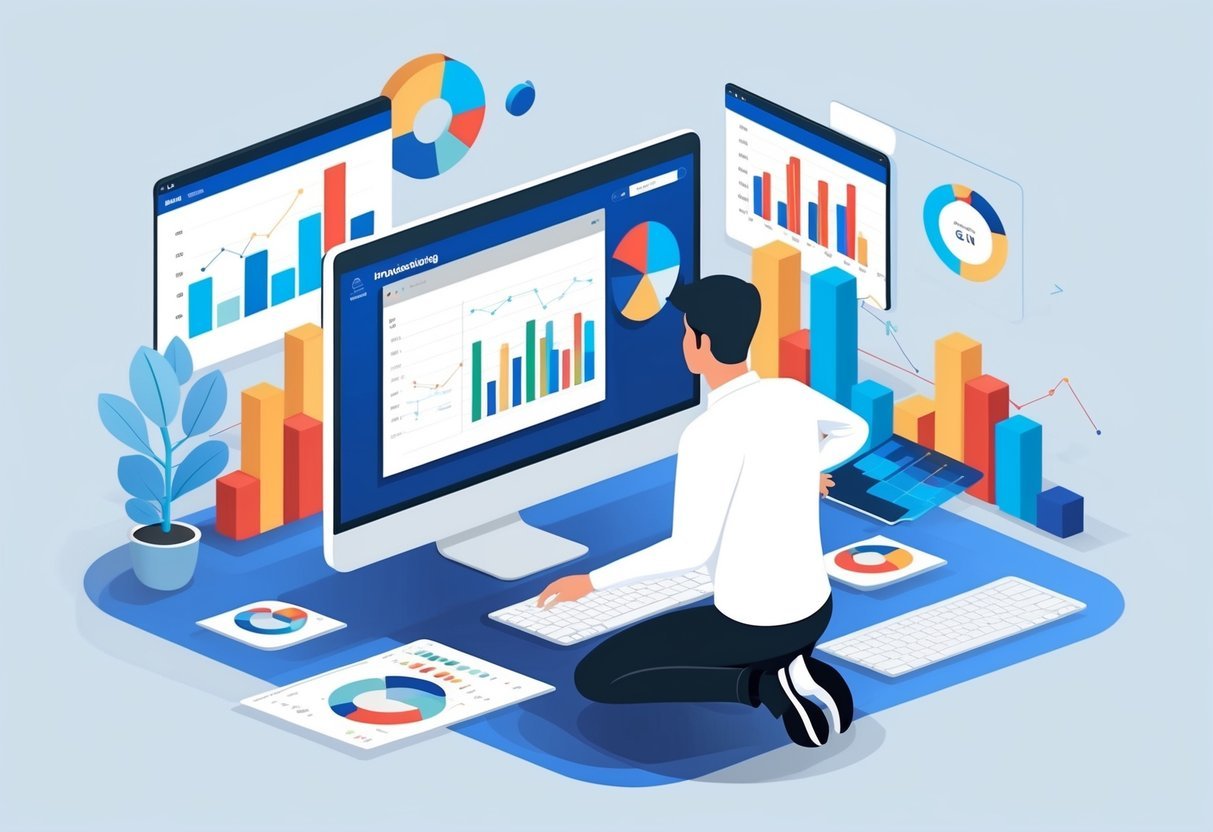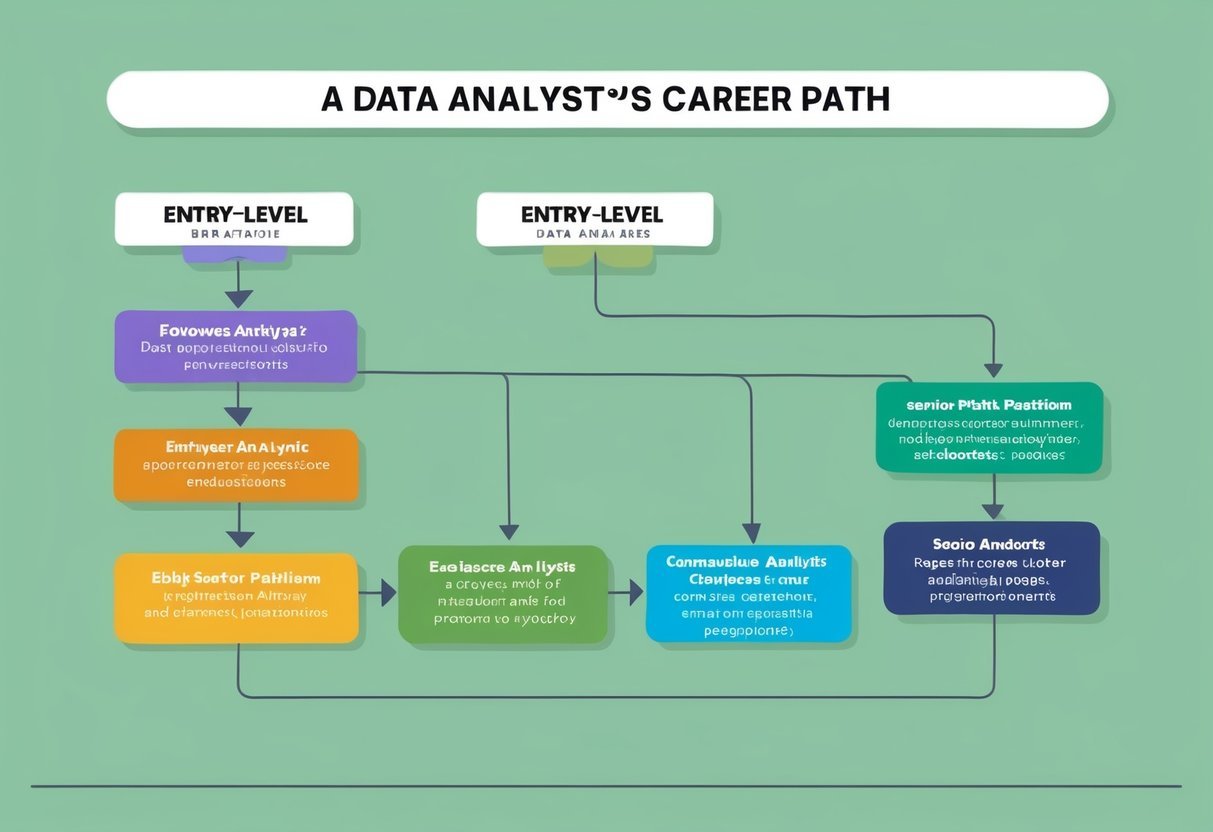Understanding the Role of Data Analysts
Data analysts play a vital part in transforming raw data into meaningful insights. They focus on examining data trends and patterns through advanced techniques.
Responsible for providing data-driven decisions, data analysts work with various tools to visualize and present their findings. This helps organizations enhance their strategies and achieve better results.
Core Responsibilities
Data analysts are tasked with collecting, cleaning, and organizing data. These tasks ensure that data sets used for analysis are accurate and relevant.
They also conduct statistical analyses to uncover patterns or trends. Analyzing the data helps provide actionable insights which businesses can use to improve their strategies.
Further, data analysts create clear and effective data visualizations that allow stakeholders to easily understand complex data.
By turning data into visual stories, they help guide data-driven decisions. Data storytelling, using understandable language and visuals, is essential to effectively communicating findings.
Key Technical Skills
A data analyst should be well-versed in data analysis tools and techniques.
Key technical skills include proficiency in software like SQL, Excel, and specialized analytics programs. Data visualization tools like Tableau or Power BI are also crucial for developing rich visual representations.
Understanding programming languages such as Python or R aids in analyzing large data sets.
Analysts must possess strong problem-solving skills. Their ability to identify and resolve data inconsistencies plays a critical role in the accuracy of their analyses.
Technical skills are complemented by excellent communication skills to effectively share insights and recommendations with non-expert audiences.
Data Analyst vs. Data Scientist
Though data analysts and data scientists both work with data, their roles differ in focus and depth. A data analyst primarily examines data to find actionable information and patterns. The role includes data cleaning, organizing, and basic reporting. Their work often centers on descriptive and diagnostic data use.
In contrast, a data scientist delves more into predictive modeling and machine learning. They develop advanced algorithms that help forecast future trends based on historical data.
Data scientists tend to work with larger data sets and use more complex tools, making their technical expertise usually broader. Analysts and scientists thus represent different steps of the data-driven decision process within a business.
Essential Data Analysis Tools
In the world of data analysis, certain tools are fundamental for extracting, analyzing, and presenting information. These tools range from databases that store data to advanced software for in-depth analysis, ending with platforms that help in visualizing findings.
Relational Database Management
Relational databases are crucial for storing and managing large amounts of data. SQL (Structured Query Language) is a powerful language used to interact with these databases.
Many data analysts rely on SQL for tasks such as querying data, updating information, and maintaining data integrity.
In addition to SQL, platforms like Microsoft Excel are often used in conjunction with databases. Excel provides functionalities like PivotTables, which help in summarizing and analyzing data efficiently.
These tools enable analysts to manage and retrieve data quickly, which is essential for making informed decisions.
Advanced Analysis Software
For deeper data analysis, software like Python and big data technologies including Hadoop and Spark are indispensable.
Python is favored for its ease of use and extensive libraries that support statistical analysis and machine learning. Analysts use Python to automate data processing and perform complex calculations that are not feasible in other tools.
Hadoop and Spark are frameworks that manage large datasets across clusters of computers, making them ideal for handling big data.
These technologies allow analysts to process and analyze vast amounts of data efficiently, which is key in extracting insights from big data.
Visualization and Reporting Tools
Visualization is a vital component of data analysis, allowing analysts to present their findings clearly.
Tools like Tableau and Power BI are popular for creating visual representations of data. These platforms help transform raw data into interactive dashboards, charts, and reports, making complex data easily understandable.
Both Tableau and Power BI offer features that allow for real-time data updates and in-depth exploration of datasets.
These visualization tools are crucial for communicating insights effectively to stakeholders who may not be familiar with raw data analysis. Furthermore, Excel remains a staple tool for creating detailed reports and conducting basic data visualization.
Statistical Analysis and Data Modeling

Statistical analysis and data modeling form the backbone of understanding data in depth. These processes help in discovering patterns, making predictions, and evaluating outcomes with accuracy. They facilitate actionable insights and predictive analytics crucial for business success.
Applying Statistical Methods
Statistical analysis is essential for extracting meaningful information from raw data. It involves techniques like regression analysis, hypothesis testing, and variance analysis to identify trends and relationships.
Data analysts use these methods to make sense of complex datasets, enabling informed decisions. In organizations, this kind of analysis is crucial for understanding customer behaviors, market trends, and operational efficiencies.
Analysts rely on tools like R and Python, which have rich libraries for statistical computations. These tools allow for robust statistical processes, reducing errors and increasing reliability, which is vital in sectors such as finance and healthcare.
Creating Predictive Models
Predictive models are the result of applying statistical methods to forecast future events. Data modeling involves designing mathematical models that predict outcomes based on historical data.
A key component is using machine learning algorithms to enhance model accuracy.
Through techniques like decision trees and neural networks, these models can predict customer demand, assess risks, or even personalize product recommendations.
Data analysts must focus on creating and validating these models to provide reliable predictions. This process involves iterative testing and feedback loops.
Understanding model limitations and continuously refining them is important for successful predictive analytics and maintaining trust in the insights derived.
Effective Data Communication

Effective communication in data analytics involves both conveying complex data insights clearly and engagingly and working with stakeholders. Mastering these skills enables data analysts to present information in a way that drives decision-making and ensures successful collaboration.
Storytelling with Data
Data storytelling is a crucial skill that transforms raw data into a narrative that is easily understood. By using data visualization tools like Excel, Tableau, or Power BI, analysts can create charts and graphs that highlight trends and patterns.
This helps in simplifying complex information, making it more digestible.
The story often follows a structure, including an introduction, main content, and conclusion. This approach aids in engaging the audience and conveying the key insights effectively.
Through a well-crafted story, readers can better understand the implications of the data, which is essential for strategic decision-making.
Interacting with Stakeholders
For a data analyst, communicating effectively with stakeholders is vital. Stakeholders may include managers, team members, or clients who rely on accurate and meaningful insights.
Analysts need to adapt their communication style depending on the audience’s technical expertise.
Active listening and asking the right questions help to clarify stakeholder needs, ensuring the analysis addresses their concerns.
Additionally, involving stakeholders throughout the process enhances transparency and trust.
By presenting findings clearly using accessible language and relevant visuals, analysts can support stakeholders in translating data into actionable strategies.
These communication skills are essential for success and enable a data analyst to play a significant role in decision-making processes across various industries.
Data Cleaning and Preparation

To get the best results, data cleaning and preparation are essential for transforming raw data into a format ready for analysis. By utilizing various techniques, one can ensure that the datasets are accurate and dependable, creating a strong base for further examination.
Data Wrangling Techniques
Data wrangling refers to the process of converting raw data into a more usable form. This includes steps like removing duplicates, filling in missing values, and transforming data formats.
Tools such as Python and libraries like Pandas are often used to automate these tasks, saving time and minimizing errors.
Common techniques involve normalizing data and aggregating information from multiple sources. For instance, data analysts regularly use methods to handle outliers and irrelevant data points, ensuring the datasets are consistent.
Incorporating these practices enhances the quality and reliability of the data, which is crucial for any data analysis project.
Ensuring Data Quality
Maintaining high data quality is vital to the success of any analytical work. It involves validating data accuracy and checking for inconsistencies.
Data analysts must employ rigorous methods to ensure the data’s integrity, such as running regular audits and validation checks.
It’s important to have a systematic approach for correcting any errors found. This can include creating validation rules or using automated tools to flag anomalies.
Analysts often rely on data cleaning methods to scrutinize datasets, ensuring they meet the required standards before proceeding with analysis.
An organized data environment supports better decision-making and leads to more reliable insights.
Business Intelligence and Analytics

Business intelligence (BI) and analytics play crucial roles in supporting data-driven decisions within organizations. These processes help in turning raw data into meaningful insights, enabling business analysts and business intelligence analysts to identify trends and make informed choices.
Integrating BI in Data Analysis
Integrating BI into data analysis involves using tools and technologies to collect, store, and analyze data. This integration allows businesses to transform complex data sets into easy-to-understand formats.
BI tools, such as dashboards and reporting software, provide visuals like charts and graphs that simplify data interpretation for business analysts.
BI helps organizations in identifying operational efficiencies, spotting market trends, and recognizing customer preferences.
When business intelligence is effectively integrated, companies can ensure that their data analysis solutions support strategic goals, offering a competitive edge in the marketplace.
Advanced analytics techniques, including predictive modeling and machine learning, can enhance this integration by adding depth and accuracy to data-driven decisions.
Extracting Actionable Insights
Extracting actionable insights from data is a critical function of business intelligence. By analyzing data trends and patterns, business intelligence analysts can forecast outcomes and influence strategy.
This requires the ability to interpret data accurately and predict future scenarios, which is crucial for businesses looking to adapt and grow.
Tools and techniques such as data mining and cluster analysis enable the extraction of valuable insights that inform decision-making processes.
The result is a deeper understanding of business performance and customer behavior. This approach helps in optimizing marketing strategies, improving operational efficiencies, and enhancing customer satisfaction, all of which are essential for sustainable business success.
Specialized Areas of Analysis

Specialized areas of data analysis play a crucial role in various industries. With advancements in technology, data analysts are needed to address unique challenges across different sectors and emerging fields.
Sector-Specific Data Analysis
Data analysts often focus on particular industries, tailoring their skills to meet specific needs.
For instance, in healthcare, analysts work to manage and interpret patient data, aiding in clinical decisions and improving patient outcomes.
In finance, they assess market trends and financial risks, providing insights for better investment strategies.
In other areas like retail, data analysts focus on consumer behavior to optimize sales and marketing strategies. Information security analysts in sectors such as IT work to prevent data breaches by analyzing security breaches and developing protocols to strengthen the defenses.
Emerging Fields and Technologies
With technology evolving rapidly, new avenues in data analysis have emerged.
The field of machine learning and big data offers opportunities to develop models that predict trends and automate processes.
Analysts work with machine learning models to create advanced algorithms that improve decision-making and efficiency.
Data mining allows for deeper exploration of large datasets, uncovering patterns and correlations not immediately obvious.
As these technologies advance, new roles such as data engineers and statisticians are more crucial, focusing on creating architectures that support complex data systems and analytics.
These positions require specialized skills in statistics and programming, driving innovation across various sectors.
Career Path and Progression

The career path for a data analyst involves a range of opportunities for growth, educational advancement, and possible transitions to related fields. Individuals often start in junior roles and can move to senior positions as they gain experience. Education plays a crucial role in advancing one’s career. Transitioning to related roles like data scientist or operations analyst is also common.
From Junior to Senior Roles
As individuals begin their careers in data analysis, they often start as associate data analysts. In this role, they focus on collecting, processing, and performing statistical analyses on data.
With experience, they may progress to become mid-level analysts. At this stage, they work on complex projects and might lead small teams.
Continuing from mid-level, a professional may become a senior data analyst. In this position, responsibilities expand to include strategic initiatives and influencing decision-making processes. They also mentor junior staff.
Career advancement depends heavily on demonstrated skills and accomplishments, along with the ability to drive results in data-driven projects.
Academic and Continuous Learning
Education serves as a foundation for a career in data analysis. While a bachelor’s degree in fields such as statistics, computer science, or mathematics is often required, some may opt for a master’s degree to further enhance their skills.
Continuous learning is essential, as technology and methodologies in data analysis frequently evolve.
Many analysts participate in online courses, workshops, and seminars to stay current with industry trends. Certifications in specialized tools, like SQL or Python, can also improve career prospects.
This continuous dedication to learning helps analysts adapt to advancements in the field and enables them to take on more complex roles over time.
Transitioning to Related Roles
Data analysts often have opportunities to transition into different roles within or outside their organization. Many choose to become data scientists, which requires additional skills in machine learning and predictive modeling.
Others may pivot towards becoming operations analysts, focusing on improving business processes.
These transitions allow for broader career opportunities and can lead to roles that involve more strategic planning and decision-making.
Gaining expertise in data visualization and business intelligence tools can facilitate these transitions, providing the necessary skills to excel in these new capacities and enhance career advancement.
Industry Standards and Best Practices

Data analysts navigate a world grounded in precise standards and ethical guidelines. Ensuring data accuracy and legal compliance forms the backbone of effective data management.
Maintaining Data Integrity
Data integrity is vital for reliable analysis. Data integrity means upholding accuracy and consistency over its lifecycle. Analysts prioritize collecting and organizing precise data to facilitate quality insights.
Techniques for maintaining integrity include using tools like R programming for data validation. Analysts often rely on robust data sources and implement systematic checks.
Maintaining data integrity is crucial when dealing with big data, where errors can significantly impact outcomes. Using backup plans and rigorous validation processes can help minimize risks.
Keeping data secure is another critical aspect, often involving collaboration with an information security analyst to protect against breaches. This ensures collected data remains unaltered and trusted.
Adhering to Legal and Ethical Guidelines
Data analysts must follow strict legal frameworks to protect privacy and ensure ethical use of information. Regulations like GDPR set clear rules about data handling and consent.
Compliance requires a firm grasp of legal standards and company policies. Analysts should receive regular training on privacy laws to stay updated. Understanding these frameworks helps prevent data misuse and maintains public trust.
They also follow ethical guidelines to avoid biases in data interpretation and presentation. Data literacy programs can enhance understanding of ethical considerations. Awareness fosters responsible data use and creates a transparent working environment.
Problem-Solving and Critical Thinking

Effective problem-solving and critical thinking are crucial for data analysts. They involve evaluating complex datasets and drawing meaningful insights. These skills help analysts break down challenges and create data-driven solutions.
Approach to Tackling Data Challenges
Data analysts are often faced with complex tasks that require a strategic approach. They begin by clearly defining the problem. This first step is essential to ensure that efforts are focused and effective.
Once the problem is understood, they gather relevant data, ensuring its accuracy and completeness.
Next, they use powerful tools and techniques to clean and process the data. For example, data analysts might use SQL to sort and filter large datasets with ease.
Applying statistical methods is another common practice to analyze and interpret the information accurately.
The ability to spot patterns and anomalies in data is critical. Data analysts leverage skills like critical thinking and problem-solving to develop hypotheses and test them.
They iterate on their approach based on findings, refining their analyses to better understand the underlying data story.
Developing Analytical Thought Process
Analytical thinking is at the core of data analysis. It requires a logical and methodical approach, where questioning assumptions is key.
Analysts must examine all angles of a problem before drawing conclusions. They need to employ strategies that foster a deep exploration of data.
Building an analytical thought process involves training in varied analytical techniques. Data analysts enhance their skills by engaging in activities that demand logical reasoning and precision.
Working with diverse datasets helps them build a robust analytical mindset.
Moreover, analysts continuously seek knowledge to stay updated with the latest tools and techniques. This ongoing learning develops their ability to break down complex problems into manageable parts. Such expertise enables them to find correlations and causations within the data confidently.
Data Analysts in the Job Market

Data analysts are vital in today’s data-driven business environment, as they help companies make informed decisions. This section explores the high demand for these professionals and what they can expect to earn in this dynamic field.
Demand and Job Security
Data analysts are in high demand as businesses across industries look to leverage data for strategic insights. Companies depend on data analysts to identify patterns and trends that inform business decisions.
The increasing use of AI to handle routine data-related tasks allows data analysts to focus on critical analysis and strategy. This shift has further escalated the need for skilled analysts, making the profession both secure and promising.
Many large companies like Cigna offer diverse roles, including claims analysis and risk assessment, demonstrating the importance of data analysts in various sectors.
Those starting a career as a data analyst can expect a stable job market with numerous opportunities for advancement and specialization, especially as data continues to grow in importance in decision-making processes.
Understanding the Average Salary
The average salary for data analysts reflects their crucial role in business operations. Salaries vary depending on factors like location, experience, and industry.
Entry-level data analysts can expect competitive starting salaries, which often increase with experience and expertise in tools like Python and R. These programming languages are frequently sought in job postings, highlighting their importance in the data analyst toolkit.
Higher-level roles offer increased pay, with salaries indicating the growing recognition of data analysis as a valuable skill. This compensation is representative of the value placed on insights and strategies developed from data analysis.
Consistent demand and attractive salaries make data analyst careers appealing for those interested in data-driven problem solving.
Enhancing Skills with Training and Certifications

To excel in data analysis, it’s crucial to focus on education that targets both technical and coding skills. Training programs and certifications can guide learners to proficiency in these areas, providing validation and a competitive edge.
Identifying Beneficial Courses
When seeking the right data analyst courses, it’s important to look for those that cover essential technical skills. Courses on programming languages such as Python, R, and SQL are vital. These enable analysts to manipulate and interpret data effectively.
Online platforms like DataCamp and Google’s Data Analytics Certificate offer structured learning paths. These courses often provide a mix of lectures, hands-on projects, and assessments that help build confidence in coding and analytical abilities.
Selecting courses with real-world projects ensures practical application of learned skills.
Certifications to Validate Expertise
Certifications serve as evidence of a data analyst’s capabilities and expertise in the field. Popular certifications include the Microsoft Certified: Data Analyst Associate and the Google Data Analytics Professional Certificate.
These credentials can enhance job prospects by demonstrating knowledge and skills.
Microsoft Learn offers pathways to prepare for these exams, focusing on data visualization, modeling, and report design.
Certifications are not only useful for validating skills but also for keeping up-to-date with changing technologies. Targeting certifications that are recognized industry-wide adds credibility to a professional’s profile and can be a stepping stone for career advancement.
Frequently Asked Questions
Data analysts play a crucial role in interpreting data to help businesses make informed decisions. This section covers key aspects of the role, qualifications, and skills needed for a successful career in data analysis.
What are the primary responsibilities of a data analyst?
Data analysts collect, process, and analyze large datasets to identify trends and insights. They create reports and visualizations to communicate findings, helping guide business strategies and decisions.
What qualifications are necessary for a career in data analysis?
A bachelor’s degree in fields like mathematics, computer science, or statistics is typically required. Proficiency in tools such as Excel, SQL, and data visualization software is also important.
How can one become a data analyst without prior experience?
Entry into data analysis can be achieved through online courses and certifications. Platforms like Coursera offer relevant learning programs.
Building a portfolio with projects demonstrating skills can significantly help.
Which skills are essential to succeed as a data analyst?
Essential skills include proficiency in data analysis tools, strong statistical knowledge, and the ability to communicate complex findings clearly. Problem-solving and critical thinking are also vital.
What is the typical salary range for a data analyst?
The salary of a data analyst can vary based on experience, location, and industry. Entry-level positions generally start from $50,000 annually, while experienced professionals can earn significantly more.
What do entry-level data analyst positions typically entail?
Entry-level roles often involve data collection, cleaning, and basic analysis tasks. These positions are designed to help new analysts develop their problem-solving skills and technical proficiency.
